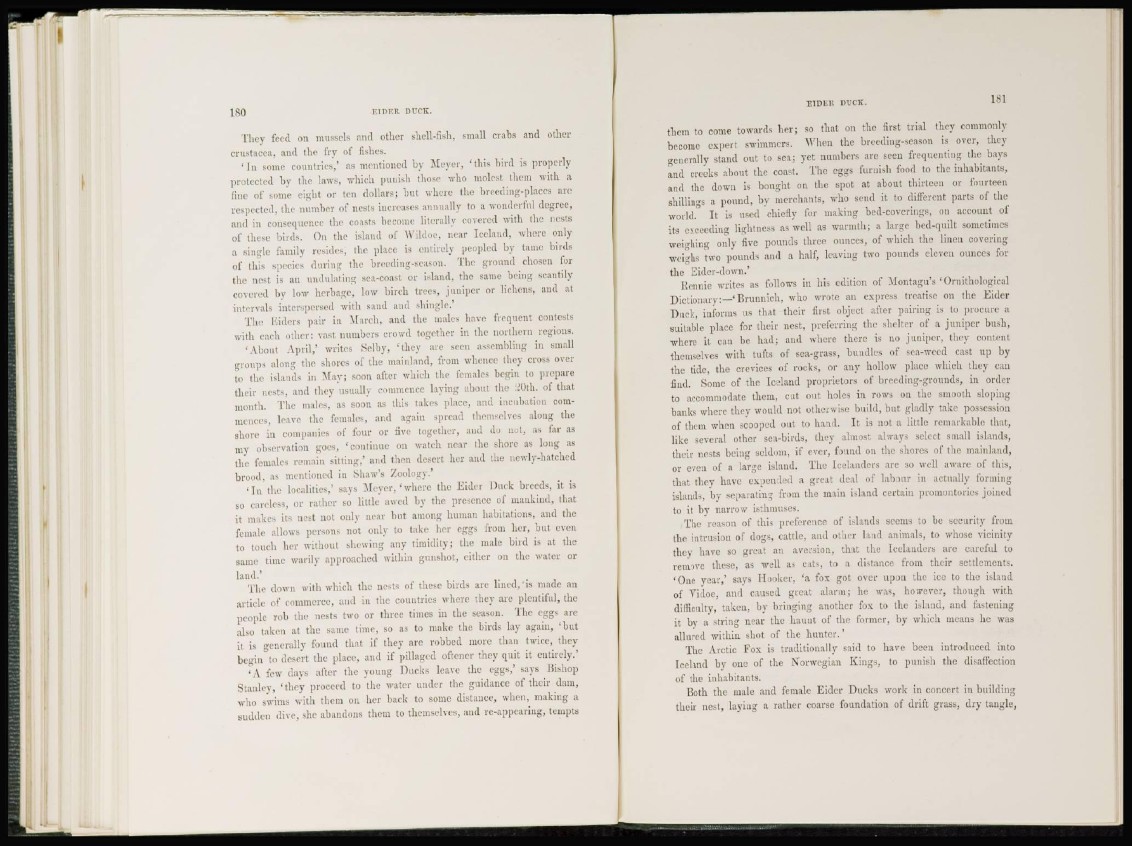
They feed on mussels mid other shell-fish, small crabs and other
Crustacea, and the fry of fishes.
' I n some countries,' as mentioned bv Mover, 'this bird is properly
protected by the laws, which punish those who molest them with a
fine of some eight or ten dollars; hut where the breeding-places are
respected, the number of nests increases annually to a wonderful degree,
and in consequence the coasts become literally covered with the nests
of t h e s e birds. On the island of Wildoe, near Iceland, where only
a single family resides, the place is entirely peopled bv tame birds
of tins species during the breeding-season. The ground chosen for
the nest is an undulating sea-coast or island, the same being scantily
covered by low herbage, low birch trees, juniper or lichens, and at
intervals interspersed with sand and shingle.*
The Eiders pair in March, and the males have frequent contests
with each other: vast numbers crowd together in the northern regions.
' About April,' writes Selby, ' they arc seen assembling in small
groups along the shores of the mainland, from whence they cross over
to the islands in May; soon after which the females begin to prepare
their nests, and they usually commence laying about the :i()th. of that
month. The males, as soon as this takes place, and incubation commences,
leave the females, and again spread themselves along the
shore in companies of four or five together, and do not, as far as
my observation goes, 'continue on watch near the shore as long as
the females remain sitting,' and then desert her and the newly-hatched
brood, as mentioned in Shaw's Zoology.*
' I n the localities," says Meyer,'where the Eider Duck breeds, it is
so careless, or rather so little awed by the presence of mankind, that
it makes its nest not only near but among human habitations, and the
female allows persons not only to take her eggs from her, but even
to touch her without shewing any timidity; the male bird is at the
same time warily approached within gunshot, cither on the water or
land.'
' t h e down with which the nests of these birds arc lined,'is made an
article of commerce, and in the countries where they are plentiful, the
people rob the nests two or three times in the season. The eggs are
also taken at the same time, so as to make the birds lay again, ' b ut
it is generally found that if they are robbed more than twice, they
begin to desert the place, and if pillaged oftener they quit it entirely.'
' A few days after the young Ducks leave the eggs,' says Bishop
Stanley, 'they proceed to tin- water under the guidance of their dam,
who swims with them on her back to some distance, when, making a
sudden dive, she abandons them to themselves, and re-appearing, tempts
them to come towards her; so that on the first trial they commonly
become expert swimmers. W'hen the breeding-season is over, they
generally stand out to sea; yet numbers are seen frequenting the bays
and creeks about the coast. The eggs furnish food to the inhabitants,
and the down is bought on the spot at about thirteen or fourteen
shillings a pound, by merchants, who send it to different parts of the
world. It is used chiefly for making bed-coverings, on account of
its exceeding lightness as well as warmth; a large bed-quilt sometimes
weighing only five pounds three ounces, of which the linen covering
weighs two pounds and a half, leaving two pounds cloven ounces for
the Eider-down.'
[Jennie writes as follows in his edition of Montagu's'Ornithological
Dictionary:—' Brunnich, who wrote an express treatise on the Eider
Duck, informs us that their first object after pairing is to procure a.
suitable place for their nest, preferring the shelter of a juniper bush,
where it can be had; and where there is no juniper, they content
themselves with tufts of sea-grass, bundles of sea-weed cast up by
the tide, the crevices of rocks, or any hollow place which they can
find. Some of the Iceland proprietors of breeding-grounds, in order
to accommodate them, cut out holes in rows on the smooth sloping
banks where they would not otherwise build, but gladly take possession
of them when scooped out. to hand. It is not a little remarkable that,
like several other sea-birds, they almost always select small islands,
their nests being seldom, if ever, found on the shores of the mainland,
or even of a large island. The Icelanders are so well aware of this,
that they have expended a great deal of labour in actually forming
islands, by separating from the main island certain promontories joined
to it by narrow isthmuses.
The reason of this preference of islands seems to be security from
the intrusion of dogs, cattle, and other land animals, to whose vicinity
they have so great an aversion, that the Icelanders arc careful to
reimvc these, as well as cats, to a distance from their settlements.
' O n e year,' says Hooker, 'a fox got over upon the ice to the island
of Vidoe, and caused great alarm; he was, however, though with
difficulty, taken, by bringing another fox to the island, and fastening
it by a string near the haunt of the former, by which means he was
allured within shot of the hunter.*
The Arctic Fox is traditionally said to have been introduced into
Iceland by one of the Norwegian Kings, to punish the disaffection
of the inhabitants.
Both the male and female Eider Ducks work in concert in building
their nest, laying a rather coarse foundation of drift grass, dry tangle,